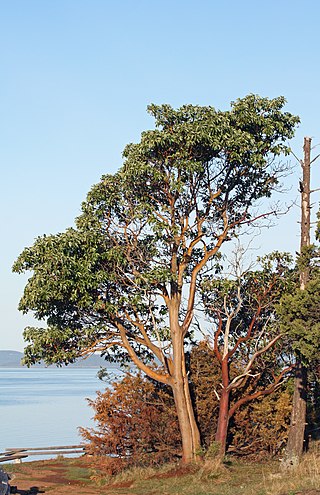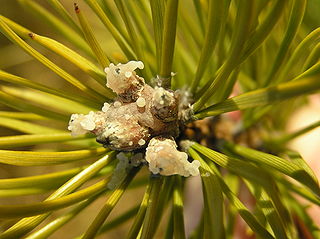Related Research Articles

Arbutus menziesii or Pacific madrone, is a species of broadleaf evergreen tree in the family Ericaceae, native to the western coastal areas of North America, from British Columbia to California. It is nicknamed the "Refrigerator Tree" due to the fact that its bark contains water, and it stays cool in the summer.

Commonly known as hellebores, the Eurasian genus Helleborus consists of approximately 20 species of herbaceous or evergreen perennial flowering plants in the family Ranunculaceae, within which it gave its name to the tribe of Helleboreae. Despite names such as "winter rose", "Christmas rose" and "Lenten rose", hellebores are not closely related to the rose family (Rosaceae). Many hellebore species are poisonous.

A plant canker is a small area of dead tissue, which grows slowly, often over years. Some cankers are of only minor consequence, but others are ultimately lethal and therefore can have major economic implications for agriculture and horticulture. Their causes include a wide range of organisms as fungi, bacteria, mycoplasmas and viruses. The majority of canker-causing organisms are bound to a unique host species or genus, but a few will attack other plants. Weather and animal damage can also cause stress to the plant resulting in cankers. Other causes of cankers is pruning when the bark is wet or using un-sterilized tools.

Citrus canker is a disease affecting Citrus species caused by the bacterium Xanthomonas. Infection causes lesions on the leaves, stems, and fruit of citrus trees, including lime, oranges, and grapefruit. While not harmful to humans, canker significantly affects the vitality of citrus trees, causing leaves and fruit to drop prematurely; a fruit infected with canker is safe to eat, but too unsightly to be sold. Citrus canker is mainly a leaf-spotting and rind-blemishing disease, but when conditions are highly favorable, it can cause defoliation, shoot dieback, and fruit drop.

Scleroderris canker, or Brunchorstia disease, Gremmeniella abietina, is a species of fungal diseases infecting coniferous forests. The main symptom is the death of the needles, leading to the death of the tree. In the forest industry, fighting off an infection of Scleroderris canker is usually not cost-effective. Clearing is often preferred over fungicidal methods, as the latter is harmful to other living organisms.

Diplodia tip blight, also known as Sphaeropsis blight, is a widespread disease affecting conifers caused by an opportunistic fungal pathogen, Diplodia sapinea. It is found in “both hemispheres between the latitudes 30° and 50° north and south". The diseases symptoms include: damping off and collar rot of seedlings, stem canker, root disease, and, most commonly, shoot blight. These symptoms have caused significant economic loss to nurseries and pine plantations. In a nursery in the north-central United States, losses of 35% have been reported. Shoot blight and eventual die back can cause a reduction of marketable volume in timber by 63%. Infection of terminal shoots can result in dead-top which significantly limits the usable length of the tree trunk. The presence of the pathogen in concert with severe weather conditions can lead to extreme loss. Following a severe hailstorm in South Africa, nearly 5,000 acres of pine plantation were infected with Diplodia tip blight. It was necessary to prematurely harvest large swaths of the plantations resulting in a loss of 45%. Areas that were not harvested prematurely still suffered an average timber loss of 11%.

Phomopsis cane and leaf spot occurs wherever grapes are grown. Phomopsis cane and leaf spot is more severe in grape-growing regions characterized by a humid temperate climate through the growing season. Crop losses up to 30% have been reported to be caused by Phomopsis cane and leaf spot.
Leptosphaeria coniothyrium is a plant pathogen. It can be found around the world.

Nectria cinnabarina, also known as coral spot, is a plant pathogen that causes cankers on broadleaf trees. This disease is polycyclic and infects trees in the cool temperate regions of the Northern Hemisphere. N. cinnabarina is typically saprophytic, but will act as a weak parasite if presented with an opportunity via wounds in the tree or other stressors that weaken the tree's defense to the disease. A study published in 2011 showed that this complex consists of at least 4 distinct species. There are only a few ways to manage this disease with techniques such as sanitation and pruning away branches that have the cankers. N. cinnabarina is not as significant a problem as other Nectria spp., some of which are the most important pathogens to infect hardwood trees.

Botryosphaeria stevensii is a fungal plant pathogen that causes cankers on several tree species including apple and juniper as well as causing cankers on grape vines. It causes branch dieback, possibly affecting a large portion of the tree canopy, and if severe it can kill entire plants.

Lasiodiplodia theobromae is a plant pathogen with a very wide host range. It causes rotting and dieback in most species it infects. It is a common post harvest fungus disease of citrus known as stem-end rot. It is a cause of bot canker of grapevine. It also infects Biancaea sappan, a species of flowering tree also known as Sappanwood.

Botryosphaeria ribis is a fungal plant pathogen that infects many trees causing cankers, dieback and death.

Diaporthe helianthi is a fungal pathogen that causes Phomopsis stem canker of sunflowers. In sunflowers, Phomopsis helianthi is the causative agent behind stem canker. Its primary symptom is the production of large canker lesions on the stems of sunflower plants. These lesions can eventually lead to lodging and plant death. This disease has been shown to be particularly devastating in southern and eastern regions of Europe, although it can also be found in the United States and Australia. While cultural control practices are the primary method of controlling for Stem Canker, there have been a few resistant cultivars developed in regions of Europe where the disease is most severe.
Coniothyrium wernsdorffiae is a plant pathogen that causes brand canker on rose. It can also be hosted by raspberry and brambleberry plants.
Diaporthe phaseolorum var. caulivora is a fungal plant pathogen which infects soybean, causing soybean stem canker.

Phytophthora kernoviae is a plant pathogen that mainly infects European beech and Rhododendron ponticum. It was first identified in 2003 in Cornwall, UK when scientists were surveying for the presence of Phytophthora ramorum. This made it the third new Phytophthora species to be found in the UK in a decade. It was named Phytophthora kernoviae after the ancient name for Cornwall, Kernow. It causes large stem lesions on beech and necrosis of stems and leaves of Rhododendron ponticum. It is self-fertile. It has also been isolated from Quercus robur and Liriodendron tulipifera. The original paper describing the species, stated it can infect Magnolia and Camellia species, Pieris formosa, Gevuina avellana, Michelia doltsopa and Quercus ilex. Since then many other plants have been identified as natural hosts of the pathogen. Molecular analysis has revealed that an infection on Pinus radiata, recorded in New Zealand in 1950, was caused by P. kernoviae. The pathogen was also noted on Drimys winteri, Gevuina avellana, Ilex aquifolium, Quercus ilex, Vaccinium myrtillus, Hedera helix, Podocarpus salignas.

Armillaria root rot is a fungal root rot caused by several different members of the genus Armillaria. The symptoms are variable depending on the host infected, ranging from stunted leaves to chlorotic needles and dieback of twigs and branches. However, all infected hosts display symptoms characteristic of being infected by a white rotting fungus. The most effective ways of management focus on limiting the spread of the fungus, planting resistant species, and removing infected material. This disease poses a threat to the lumber industry as well as affecting recreational areas.
Bot canker of oak is a disease on stems, branches and twigs of oak trees in Europe and North America. The casual agent of Bot canker of oak is the fungus Botryosphaeria corticola. Bot canker of oak causes lesions and cankers on a wide range of oaks in Europe and most recently live oaks in North America. Some infections were formerly attributed to Botryosphaeria stevensii, but most likely represent infections by Botryosphaeria corticola. Botryosphaeria corticola is distinguishable from Botryosphaeria stevensii via ITS rDNA sequencing.

Coniothyrium is a genus of fungi in the family Coniothyriaceae. The genus was circumscribed by Czech mycologist August Carl Joseph Corda in 1840. It was formerly placed in the Phaeosphaeriaceae family until 1983 when the family was established.
References
- ↑ Sacc., Nuovo G. bot. ital. 8(4): 200 (1876)
- ↑ Kilian, M.; Steiner, U. (2003). "Disease / Bactericides and Fungicides". Encyclopedia of Rose Science.
- ↑ McManus, Dayna S. (2016). "A Worldwide Yearly Survey of New Data in Adverse Drug Reactions". Side Effects of Drugs Annual.
- ↑ "Rose dieback / RHS Gardening". www.rhs.org.uk. Retrieved 31 July 2023.